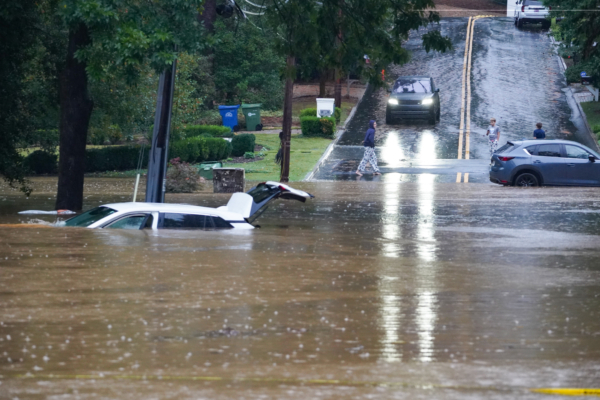“Hurricane Helene” made landfall in Florida as a Category 4 storm and has since weakened to a Category 1. It is the strongest hurricane to hit Florida’s Big Bend in recorded history. As the hurricane continues to move towards Georgia and the Carolinas, it has already caused at least six deaths and millions of people are without power along its path.
Helene is one of the largest storms in the Gulf of Mexico in recent decades, with its wind field spanning roughly the distance between Indianapolis and Washington D.C. 60 million people in 12 states across the United States received monitoring and warning alerts, with six states declared in a state of emergency.
While the storm has weakened from a Category 4 to a Category 1, it has caused widespread damage to homes and infrastructure due to heavy rain and strong winds. It continues to trigger deadly storm surges, flooding, and destructive winds.
The massive storm has passed through Florida into Georgia and the Carolinas, posing serious flood threats to these areas. As Helene moves towards Tennessee, more rainfall is expected on Friday.
In Charlotte, North Carolina, one person died and another was injured when a tree fell onto a house, according to the Mecklenburg EMS Agency. Officials in Laurens County, Georgia, reported two deaths, while Governor Brian Kemp confirmed two additional deaths in Wheeler County nearby.
Governor Ron DeSantis of Florida announced that a person died when a signboard fell onto a car near I-4 highway in Tampa.
PowerOutage.US reported that over 1.8 million customers were left without power in Florida, Georgia, and the Carolinas as Hurricane Helene swept through the Southeast. Roads were flooded, posing dangers to residents and causing disruptions in emergency services in some counties.
The Sheriff’s Office in Suwannee County, Florida, reported widespread damage on the west side of the county. Trees have fallen on houses, resulting in severe structural damage. Numerous reports of fallen trees and power lines have led to a “100% power outage” in the entire county.
After hitting the Big Bend area of Florida, Hurricane Helene moved towards the Southeast, causing six states to declare a state of emergency: Florida, Georgia, North Carolina, South Carolina, Alabama, and Virginia.
Governor DeSantis stated that 61 out of the 67 counties in Florida are currently in a state of emergency.
All 159 counties in Georgia have been placed under a state of emergency to allow emergency management teams to make necessary arrangements and deploy required resources before the storm arrives.
President Joe Biden approved an emergency declaration for Alabama and ordered federal assistance for those affected by Helene.
Governor Glenn Youngkin of Virginia stated that the state “cannot ignore the fact that we have seen significant flooding.”
Due to power outages caused by Hurricane Helene, residents in Lowndes County, southern Georgia, were instructed to evacuate.
“Due to ‘Hurricane Helene,’ Lowndes County currently has 63,000 customers without power! Lowndes County hold on, continue to evacuate.” a Lowndes County emergency management communication on social media stated.
Lowndes County, located on the border of Georgia and Florida, is approximately 60 miles from Tallahassee.
Mayor Bruce Rector of Clearwater, Florida, mentioned that Hurricane Helene inundated the coastal communities of the city in unprecedented ways. He cited reports from law enforcement and fire departments stating that all roads in the city were flooded.
“We are about 100 miles away from the storm center, but the record storm surge is nearly a meter higher than previous records.” Rector said, “This has caused unprecedented flooding in our coastal communities.”
According to the National Hurricane Center’s update early Thursday, Hurricane Helene currently has wind speeds of 90 miles per hour and is located around 30 miles north of Valdosta, Georgia.
Despite being downgraded to a Category 1 storm, Hurricane Helene is expected to bring heavy rainfall to the inland areas as it passes through Atlanta, Georgia, and moves towards Tennessee.
According to the Weather Prediction Center, Helene has brought over a foot of rainfall in some areas. Sumatra, Florida received up to 15.50 inches of rain, Busick, Georgia had 13.74 inches, and Lake Toxaway, North Carolina had 13.73 inches.
The hurricane is moving fast northeast at a speed of 26 miles per hour and is expected to turn northward overnight, bringing the storm center to central and northern Georgia on Friday morning.
Subsequently, Helene is forecasted to slow down over the Tennessee Valley on Friday night and Saturday, turning northwest.
The hurricane center warns that, “Although weakening is expected, fast-moving strong winds, particularly gusts, can still penetrate inland Southeastern United States, including higher elevation areas in the southern Appalachian Mountains.”
Tornado warnings remain in effect for parts of South Carolina, Georgia, and Florida affecting nearly 20 million people.
Mayor Liz Alpert of Sarasota, Florida, stated that Hurricane Helene could be the strongest storm the state has seen in the past century. She told CNN that despite the storm’s weakening after landfall, her city “still looks very bad.”
“This could be the worst situation in our area in a century.” She said, “I’ve been in Sarasota for 22 years, but I’ve never seen anything like this.”
A mother of three in the coastal town of Steinhatchee, Florida experienced six hurricanes in her lifetime, stating that Helene brought the most severe flooding she has ever seen.
“There’s a boat in my driveway. I’m out there fishing in our yard.” Jules Carl told CNN on Friday morning.
(This article references reports from CNN and ABC.)

